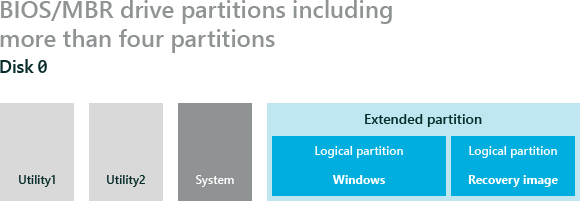Size specifies the size of the partition to create,
in megabytes (MB).
Values
|
size_in_megabytes |
Specifies the size of the partition that you create, in megabytes. For example, to create a 2 gigabyte (GB) partition, set
|
 Note Note |
|---|
Do not create a value for Size that entirely fills
or exceeds the available space, because Windows® reserves a small
amount of space to manage partitions. For example, if you create an
extended partition with 2000 MB, and you create two logical
partitions with the size of 1000 MB each inside that
partition, the second partition is not created. An error is logged,
and installation is terminated.
|
Valid Configuration Passes
windowsPE
Parent Hierarchy
Microsoft-Windows-Setup | DiskConfiguration | Disk | CreatePartitions | CreatePartition | Size
Applies To
For a list of supported Windows editions and architectures that this component supports, see Microsoft-Windows-Setup.
XML Example
Setting a Primary Partition to Fill the Available Space on a Drive
The following XML output for the
DiskConfiguration setting shows how to create two
partitions on a hard drive on a BIOS-based system. The first
partition is 300 MB. The second partition extends to fill the
remainder of the hard disk. This is shown in the following
illustration.

 Copy Code Copy Code |
|
|---|---|
<DiskConfiguration> <Disk wcm:action="add"> <DiskID>0</DiskID> <WillWipeDisk>true</WillWipeDisk> <CreatePartitions> <!-- System partition --> <CreatePartition wcm:action="add"> <Order>1</Order> <Type>Primary</Type> <Size>300</Size> </CreatePartition> <!-- Windows partition --> <CreatePartition wcm:action="add"> <Order>2</Order> <Type>Primary</Type> <Extend>true</Extend> </CreatePartition> </CreatePartitions> <ModifyPartitions> <!-- System partition --> <ModifyPartition wcm:action="add"> <Order>1</Order> <PartitionID>1</PartitionID> <Label>System</Label> <Format>NTFS</Format> <Active>true</Active> </ModifyPartition> <!-- Windows partition --> <ModifyPartition wcm:action="add"> <Order>2</Order> <PartitionID>2</PartitionID> <Label>Windows</Label> <Letter>C</Letter> <Format>NTFS</Format> </ModifyPartition> </ModifyPartitions> </Disk> <WillShowUI>OnError</WillShowUI> </DiskConfiguration> <ImageInstall> <OSImage> <InstallTo> <DiskID>0</DiskID> <PartitionID>2</PartitionID> </InstallTo> </OSImage> </ImageInstall> |
|
Setting a Logical Partition to Fill the Available Space in an Extended Partition
The following XML output for the
DiskConfiguration setting shows how to create an
extended partition that fills the remainder of the drive on a
BIOS-based system. The extended partition includes two logical
partitions. The first logical partition is 15 GB. The second
logical partition extends to fill the remainder of the extended
partition. This is shown in the following illustration.

 Copy Code Copy Code |
|
|---|---|
<DiskConfiguration> <Disk wcm:action="add"> <DiskID>0</DiskID> <WillWipeDisk>true</WillWipeDisk> <CreatePartitions> <!-- Recovery partition --> <CreatePartition wcm:action="add"> <Order>1</Order> <Type>Primary</Type> <Size>3000</Size> </CreatePartition> <!-- Utility2 partition --> <CreatePartition wcm:action="add"> <Order>2</Order> <Type>Primary</Type> <Size>250</Size> </CreatePartition> <!-- System partition --> <CreatePartition wcm:action="add"> <Order>3</Order> <Type>Primary</Type> <Size>100</Size> </CreatePartition> <!-- Extended partition --> <CreatePartition wcm:action="add"> <Order>4</Order> <Type>Extended</Type> <Extend>true</Extend> </CreatePartition> <!-- Windows partition --> <CreatePartition wcm:action="add"> <Order>5</Order> <Type>Logical</Type> <Size>15000</Size> </CreatePartition> <!-- Logical2 partition --> <CreatePartition wcm:action="add"> <Order>6</Order> <Type>Logical</Type> <Size>100</Size> <!-- Note: To create a logical partition that fills the rest of the extended partition, create the data partition with an initial size of 100 MB. This will be changed in the ModifyPartition section. --> </CreatePartition> </CreatePartitions> <ModifyPartitions> <!-- Recovery partition --> <ModifyPartition wcm:action="add"> <Order>1</Order> <PartitionID>1</PartitionID> <Label>Recovery</Label> <Format>NTFS</Format> <TypeID>0x27</TypeID> </ModifyPartition> <!-- Utility2 partition --> <ModifyPartition wcm:action="add"> <Order>2</Order> <PartitionID>2</PartitionID> <Label>Utility2</Label> <Letter>U</Letter> <Format>NTFS</Format> <TypeID>0x27</TypeID> </ModifyPartition> <!-- System partition --> <ModifyPartition wcm:action="add"> <Order>3</Order> <PartitionID>3</PartitionID> <Label>System</Label> <Format>NTFS</Format> <Active>true</Active> </ModifyPartition> <!-- Extended partition: This partition does not need receive a partition number, nor does it need to be modified --> <!-- Windows partition --> <ModifyPartition wcm:action="add"> <Order>4</Order> <PartitionID>4</PartitionID> <Label>Windows</Label> <Letter>C</Letter> <Format>NTFS</Format> </ModifyPartition> <!-- Logical2 partition --> <ModifyPartition wcm:action="add"> <Order>5</Order> <PartitionID>5</PartitionID> <Label>Logical2</Label> <Letter>L</Letter> <Format>NTFS</Format> <Extend>true</Extend> <!-- Note: When modifying a logical partition, setting "ModifyPartition|Extend=true" sets the partition to fill the remainder of the extended partition. This overrides the "CreatePartition|Size" value. --> </ModifyPartition> </ModifyPartitions> </Disk> <WillShowUI>OnError</WillShowUI> </DiskConfiguration> <ImageInstall> <OSImage> <InstallTo> <DiskID>0</DiskID> <PartitionID>4</PartitionID> </InstallTo> </OSImage> </ImageInstall> |
|
For full XML examples and recommended partition configurations, see How to Configure UEFI/GPT-Based Hard Disk Partitions or How to Configure BIOS/MBR-Based Hard Disk Partitions.




